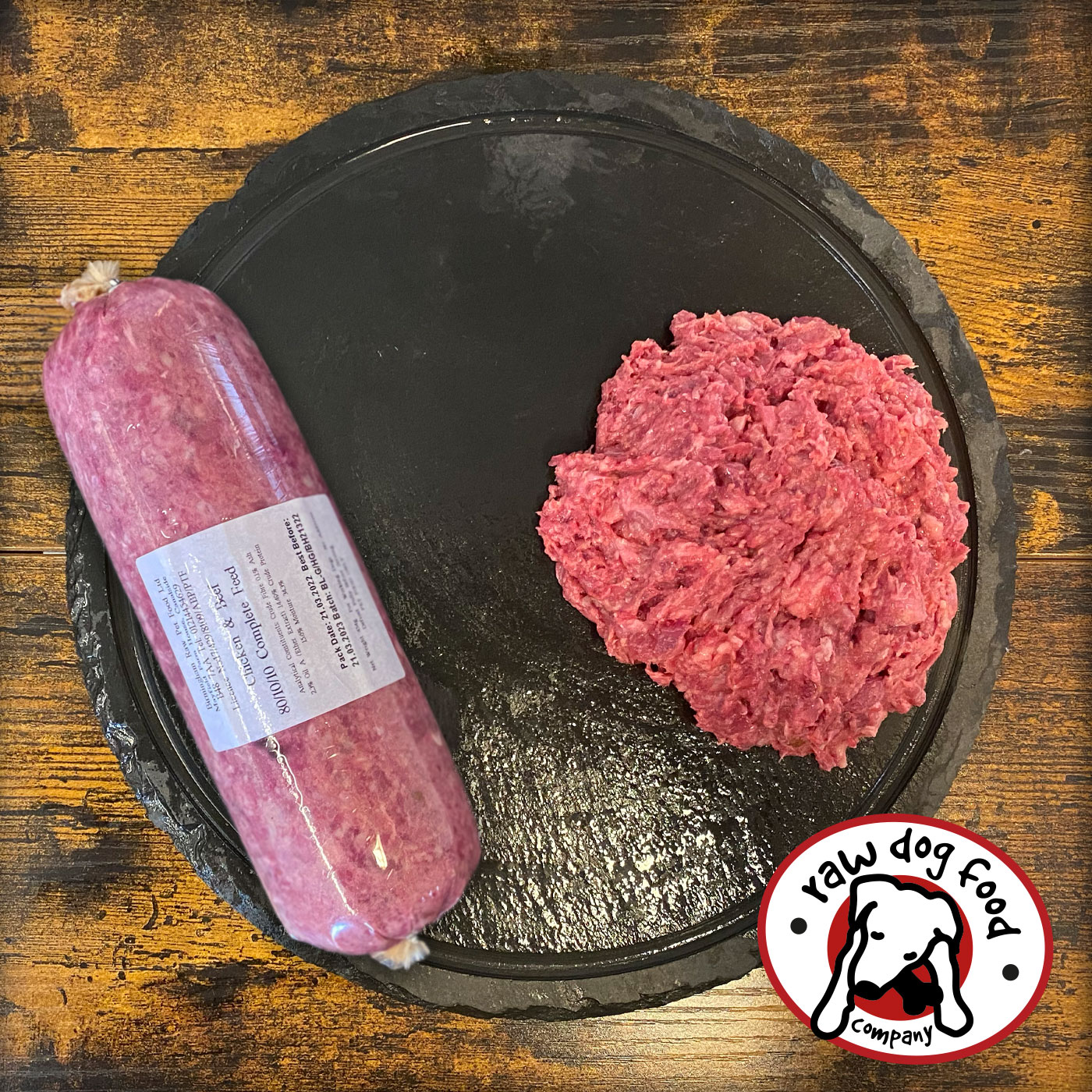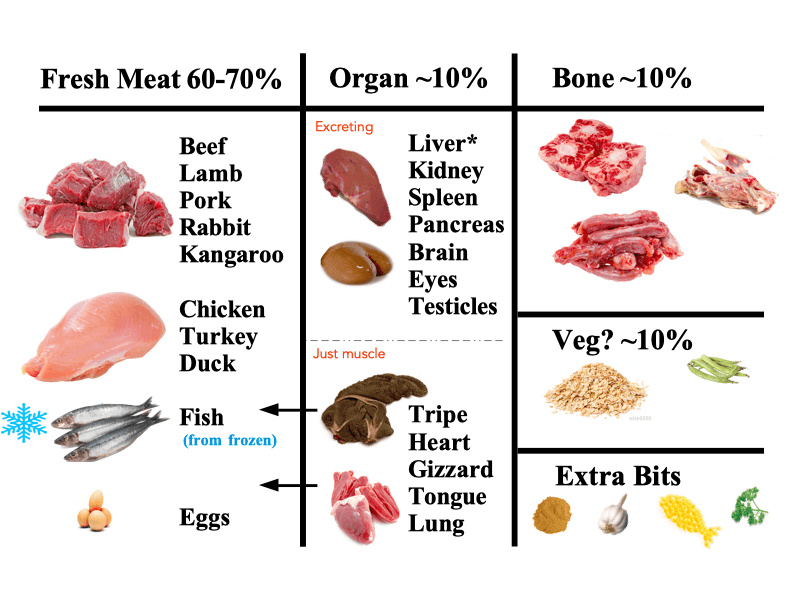Complete raw dog food consists of unprocessed, whole ingredients designed to meet a dog's nutritional needs. This diet often includes raw meat, bones, fruits, and vegetables.
Raw dog food has gained popularity among pet owners seeking a natural diet for their furry companions. Advocates believe it offers health benefits, such as improved digestion, shinier coats, and increased energy levels. This diet mimics what dogs would eat in the wild, focusing on high-quality protein and essential nutrients.
Transitioning to raw food requires careful planning to ensure a balanced meal that meets all dietary needs. It's crucial to research and consult with a veterinarian before making the switch. Understanding the components of complete raw dog food helps create a healthy and enjoyable diet for your pet.
Introduction To Raw Dog Food
Raw dog food is gaining popularity among pet owners. This diet mimics what dogs would eat in the wild. It includes raw meat, bones, fruits, and vegetables. Many believe this diet can improve their dogs' health.
Origins Of The Raw Food Movement For Dogs
The raw food movement began in the 1990s. Veterinarian Ian Billinghurst introduced the concept. He believed dogs thrive on a diet similar to their ancestors. This diet is often called the BARF diet, which stands for “Biologically Appropriate Raw Food.”
- Raw meat
- Raw bones
- Fruits
- Vegetables
Many pet owners started to adopt this approach. They reported improved health in their dogs. The movement gained momentum through social media and blogs.
Potential Benefits For Canine Health
Raw dog food may offer several benefits. Some of these benefits include:
- Better digestion: Raw food can enhance nutrient absorption.
- Healthier skin and coat: Dogs often have shinier fur.
- Increased energy levels: Many dogs become more active.
- Weight management: Raw food can help maintain a healthy weight.
Some studies suggest that raw diets may reduce allergies. Dogs may have fewer gastrointestinal issues. Raw diets often contain fresh ingredients, which can improve overall well-being.
| Benefit | Description |
|---|---|
| Better Digestion | Raw food promotes better nutrient absorption. |
| Healthier Skin and Coat | Raw diets can lead to shinier and healthier fur. |
| Increased Energy Levels | Raw food can make dogs more active. |
| Weight Management | Helps maintain a healthy weight. |
Choosing a raw diet requires careful planning. Consult a veterinarian before making changes. They can help ensure a balanced diet for your dog.

Credit: dragonflyproducts.co.uk
Debunking Myths Around Raw Feeding
Many dog owners hesitate to try raw dog food. They worry about safety and health risks. Let's explore and debunk common myths surrounding raw feeding. Understanding the facts can help you make informed choices for your furry friend.
Busting Common Misconceptions
Several myths cloud the truth about raw feeding. Here are some common misconceptions:
- Raw food causes nutritional deficiencies. Many raw diets are balanced and complete.
- Raw diets lead to aggression. Aggression is not linked to diet.
- Raw feeding is too complicated. Simple recipes and pre-made options exist.
- Raw feeding is only for certain breeds. All dogs can thrive on a raw diet.
Understanding these myths helps pet owners feel more confident.
Real Risks Vs. Presumed Dangers
People often worry about the risks of raw feeding. Here are some real concerns:
| Concern | Reality |
|---|---|
| Bacterial contamination | Proper handling and hygiene reduce this risk. |
| Parasites | Freezing meat kills many parasites. |
| Unbalanced diet | Consulting a vet ensures balanced nutrition. |
| Choking hazards | Cutting food into smaller pieces minimizes risk. |
Awareness of real risks helps owners take proper precautions. Always prioritize your dog’s health and safety.
Key Ingredients Of A Balanced Raw Diet
A balanced raw diet for dogs includes various key ingredients. These ingredients provide essential nutrients. They help maintain your dog’s health and vitality. Understanding these ingredients is crucial for every dog owner.
Proteins: The Building Blocks
Proteins serve as the foundation of a raw diet. They support muscle growth and repair. Dogs require high-quality protein sources for optimal health. Here are some common protein sources:
- Beef
- Chicken
- Turkey
- Fish
- Lamb
Each protein source provides unique benefits:
| Protein Source | Benefits |
|---|---|
| Beef | Rich in iron and zinc |
| Chicken | Good for lean muscle |
| Turkey | Low in fat, high in protein |
| Fish | Contains omega-3 fatty acids |
| Lamb | Great for sensitive stomachs |
Choose protein sources based on your dog's needs. Rotate proteins to provide variety and prevent allergies.
Vitamins And Minerals: Essential Additions
Vitamins and minerals are vital for overall health. They support bodily functions and boost the immune system. Incorporate a variety of fruits and vegetables for these nutrients. Here are some excellent choices:
- Carrots: High in beta-carotene
- Spinach: Full of iron and vitamins
- Blueberries: Packed with antioxidants
- Sweet Potatoes: Great source of fiber
- Broccoli: Contains vitamins C and K
These additions enhance the nutritional value of your dog’s diet. Always ensure proper balance to avoid deficiencies or excesses.
Monitor your dog’s health regularly. Adjust the diet as needed to maintain a balanced raw diet.
Preparing Raw Meals At Home
Preparing raw meals at home for your dog is simple and rewarding. You ensure your pet gets fresh, nutritious ingredients. Homemade meals can improve your dog's health and energy. Follow these steps to create balanced raw diets.
Essential Tools And Equipment
Gathering the right tools makes meal preparation easier. Here’s a list of essential items:
- Cutting board: A sturdy surface for chopping ingredients.
- Sharp knife: For cutting meat and vegetables.
- Measuring cups: Ensure accurate portion sizes.
- Mixing bowls: To combine ingredients.
- Food processor: For grinding meats or vegetables.
- Storage containers: Keep meals fresh in the fridge or freezer.
- Scale: Weigh ingredients for precise measurements.
Step-by-step Meal Preparation
Follow these steps to prepare balanced raw meals:
- Choose protein sources: Select meats like chicken, beef, or fish.
- Add vegetables: Include carrots, spinach, or pumpkin for fiber.
- Incorporate healthy fats: Use fish oil or flaxseed oil for omega-3s.
- Add supplements: Consider calcium and vitamins for balance.
- Mix ingredients: Combine protein, veggies, fats, and supplements.
- Portion meals: Use measuring cups to create daily servings.
- Store properly: Refrigerate or freeze meals for freshness.
Preparing raw dog food at home can be fun. Your dog will appreciate the effort and enjoy the meals!
Transitioning Your Dog To Raw Food
Switching your dog to raw dog food can be exciting. This diet offers many health benefits. Properly transitioning your dog ensures they adapt well. Follow these guidelines for a smooth change.
Assessing Your Dog’s Readiness
Not every dog is ready for a raw food diet. Assess your dog’s health and habits. Consider the following factors:
- Age: Puppies may need special care.
- Health: Consult your vet for any issues.
- Dietary History: Previous diets affect the transition.
- Behavior: Watch for any signs of anxiety or stress.
Ensure your dog is healthy before switching diets. A vet check can help identify any potential problems.
Gradual Switch Vs. Immediate Changeover
Decide on a method for switching to raw dog food. Two main approaches exist: gradual switch and immediate changeover.
| Method | Description | Pros | Cons |
|---|---|---|---|
| Gradual Switch | Slowly mix raw food with current food. |
|
|
| Immediate Changeover | Switch to raw food all at once. |
|
|
Choose the method that best suits your dog. Monitor their reaction closely. Adjust your approach as needed for their comfort.

Credit: blog.homesalive.ca
Raw Diet Variations And Recipes
The raw dog food diet offers many variations and delicious recipes. Pet owners can choose between homemade meals and commercial options. Each choice has unique benefits, flavors, and nutritional values.
Homemade Vs. Commercial Options
Deciding between homemade and commercial raw dog food can be tough. Here are some key points to consider:
- Homemade Raw Food: Allows full control over ingredients.
- Cost-effective: Often cheaper than store-bought options.
- Fresh Ingredients: Ensures quality and safety.
- Time-consuming: Requires meal prep and planning.
On the other hand, commercial options also have their perks:
- Convenient: Ready-to-serve meals save time.
- Balanced Nutrition: Formulated by pet nutrition experts.
- Variety: Many flavors and protein sources available.
- Cost: Can be more expensive than homemade meals.
Sample Meal Plans And Recipes
Creating a balanced raw diet is simple. Here are some sample meal plans and recipes:
| Day | Protein Source | Vegetables | Supplements |
|---|---|---|---|
| Monday | Chicken thighs | Carrots | Fish oil |
| Tuesday | Beef chunks | Spinach | Calcium powder |
| Wednesday | Turkey necks | Broccoli | Probiotic supplement |
| Thursday | Lamb liver | Sweet potatoes | Vitamin E |
| Friday | Fish fillets | Zucchini | Zinc supplement |
Here are some easy recipes for homemade raw meals:
- Chicken and Veggie Mix:
- 2 lbs ground chicken
- 1 cup chopped carrots
- 1 cup spinach
- 1 tablespoon fish oil
- Beef and Sweet Potato Stew:
- 2 lbs beef chunks
- 1 cup diced sweet potatoes
- 1/2 cup peas
- 1 tablespoon calcium powder
- Turkey and Broccoli Bowl:
- 2 lbs ground turkey
- 1 cup broccoli florets
- 1 tablespoon probiotic supplement
These meal plans and recipes provide balanced nutrition for your furry friend. Experiment with different protein sources and veggies to keep meals exciting.
Monitoring Your Dog’s Health On Raw Food
Switching to complete raw dog food can be a big change. It’s important to keep track of your dog’s health during this transition. Monitoring will help you understand how well your dog adapts to this diet. Watch for positive signs and know when to seek help.
Signs Of Improved Well-being
As your dog adjusts to a raw food diet, look for these signs of improved health:
- Shiny Coat: A glossy, healthy coat indicates good nutrition.
- Increased Energy: More playfulness shows your dog feels better.
- Healthy Weight: Maintaining an ideal weight is key for overall health.
- Better Digestion: Fewer gas or digestive issues suggest a good diet.
- Improved Teeth: Less plaque buildup means better oral health.
Keep a journal to track these signs. It helps you notice patterns over time. Regular observations make it easier to spot changes.
When To Consult A Veterinarian
Some signs may indicate that your dog needs medical attention. Consult a veterinarian if you notice:
- Persistent Diarrhea: Lasting more than a day can be serious.
- Vomiting: Frequent vomiting needs immediate care.
- Lethargy: Lack of energy over several days is concerning.
- Weight Loss: Rapid weight loss can indicate health issues.
- Allergic Reactions: Skin irritations or itching require professional help.
Always trust your instincts. If something seems off, reach out to your vet. Regular check-ups are essential for maintaining your dog’s health.
Cost Analysis Of Raw Feeding
Understanding the costs of raw feeding is essential for pet owners. This approach can be rewarding but requires careful budgeting. Analyzing costs helps determine if it fits your finances.
Budgeting For Raw Ingredients
Raw dog food consists of various ingredients. Planning your budget can make raw feeding manageable. Here are some key factors to consider:
- Meat: The primary ingredient, often the most expensive.
- Vegetables: Add nutrients and fiber; usually less costly.
- Supplements: Essential for balanced nutrition; prices vary.
Here’s a simple budgeting table:
| Ingredient Type | Average Monthly Cost |
|---|---|
| Meat (e.g., chicken, beef) | $100 – $300 |
| Vegetables (e.g., carrots, spinach) | $20 – $50 |
| Supplements (e.g., fish oil) | $15 – $30 |
Estimate your monthly costs based on your dog's size and diet. Adjust your shopping list according to seasonal prices.
Comparing Costs With Traditional Diets
Raw feeding can be more or less expensive than traditional diets. Comparing these costs helps make informed decisions. Here’s a breakdown:
| Feeding Method | Average Monthly Cost |
|---|---|
| Raw Diet | $135 – $380 |
| Commercial Dry Food | $60 – $150 |
| Commercial Wet Food | $70 – $200 |
Consider these factors:
- Quality: Raw food may offer better nutrition.
- Health Benefits: Potential savings on vet bills.
- Time: Preparing raw meals requires more effort.
Ultimately, the choice depends on your dog's needs and your financial goals.
Legal And Ethical Considerations
Understanding the legal and ethical aspects of Complete Raw Dog Food is crucial. Pet owners must ensure they follow regulations. They should also consider the ethical sourcing of ingredients.
Regulations On Raw Food For Dogs
Raw dog food regulations vary by country and region. Here are some important points:
- FDA Guidelines: The Food and Drug Administration monitors pet food safety.
- AAFCO Standards: The Association of American Feed Control Officials sets nutritional guidelines.
- Local Laws: Some areas have specific laws about raw food sales.
Pet owners should check local regulations. Compliance ensures safety for pets and families.
Ethical Sourcing Of Raw Ingredients
Ethical sourcing is vital for raw dog food. It impacts animal welfare and environmental health. Consider these factors:
- Humanely Raised Animals: Choose suppliers that treat animals well.
- Organic Ingredients: Look for products that use organic farming methods.
- Sustainable Practices: Support brands that prioritize sustainability.
Research brands before purchasing. Make informed choices for your pet's health.
Community And Support
The journey to feeding your dog a complete raw diet can feel overwhelming. Connecting with others can ease this process. Community support provides valuable information and encouragement. Finding a network of fellow raw feeders can enhance your experience.
Finding Local Raw Feeding Groups
Local raw feeding groups are great for support. These groups often meet regularly. They share tips, advice, and resources. Joining a group can help you:
- Learn from experienced raw feeders
- Share your experiences
- Exchange recipes and meal ideas
- Find local suppliers for raw ingredients
To find local groups:
- Search on social media platforms like Facebook.
- Check community bulletin boards.
- Visit pet stores that promote raw feeding.
Online Resources And Forums
The internet offers a wealth of information. Online forums and websites focus on raw feeding. These platforms connect raw feeders worldwide. Here are some useful online resources:
| Resource | Description | Link |
|---|---|---|
| Raw Feeding Community | A forum for sharing tips and experiences. | www.rawfeedingcommunity.com |
| Dog Nutrition Forum | Discussion on dog diets and health. | www.dognutritionforum.com |
| Facebook Groups | Connect with local and global raw feeders. | www.facebook.com |
Forums allow you to ask questions. You can share your journey and seek advice. Engage with others to gain confidence in raw feeding.

Credit: www.rawdogfoodcompany.co.uk
Frequently Asked Questions
What Is Complete Raw Dog Food?
Complete raw dog food consists of balanced, uncooked ingredients. It typically includes raw meat, bones, organs, fruits, and vegetables. This diet aims to replicate what dogs would naturally eat in the wild. When properly formulated, it can provide all essential nutrients for your dog's health.
Is Raw Dog Food Safe For Pets?
Yes, raw dog food can be safe when prepared correctly. It's essential to source high-quality ingredients and follow hygiene practices. Consult with a veterinarian to ensure your dog receives a balanced diet. Regular monitoring of your dog's health is also crucial when transitioning to raw food.
How Do I Transition My Dog To Raw Food?
To transition your dog to raw food, start gradually. Begin by mixing a small amount of raw food with their current diet. Slowly increase the raw portion over 7-10 days. Monitor your dog’s reaction and adjust accordingly. Always ensure the new diet is balanced and nutritious.
What Are The Benefits Of Raw Dog Food?
Raw dog food offers several benefits, including improved coat condition and better digestion. Many pet owners report increased energy levels and healthier skin. A raw diet can also lead to healthier teeth and fresher breath. It's important to consult a veterinarian for proper guidance.
Conclusion
Choosing complete raw dog food can greatly enhance your pet's health and vitality. It offers essential nutrients that support strong bones and a shiny coat. Always consult your vet before making dietary changes. Embrace this journey to better nutrition for your furry friend.
A healthy dog is a happy dog!














